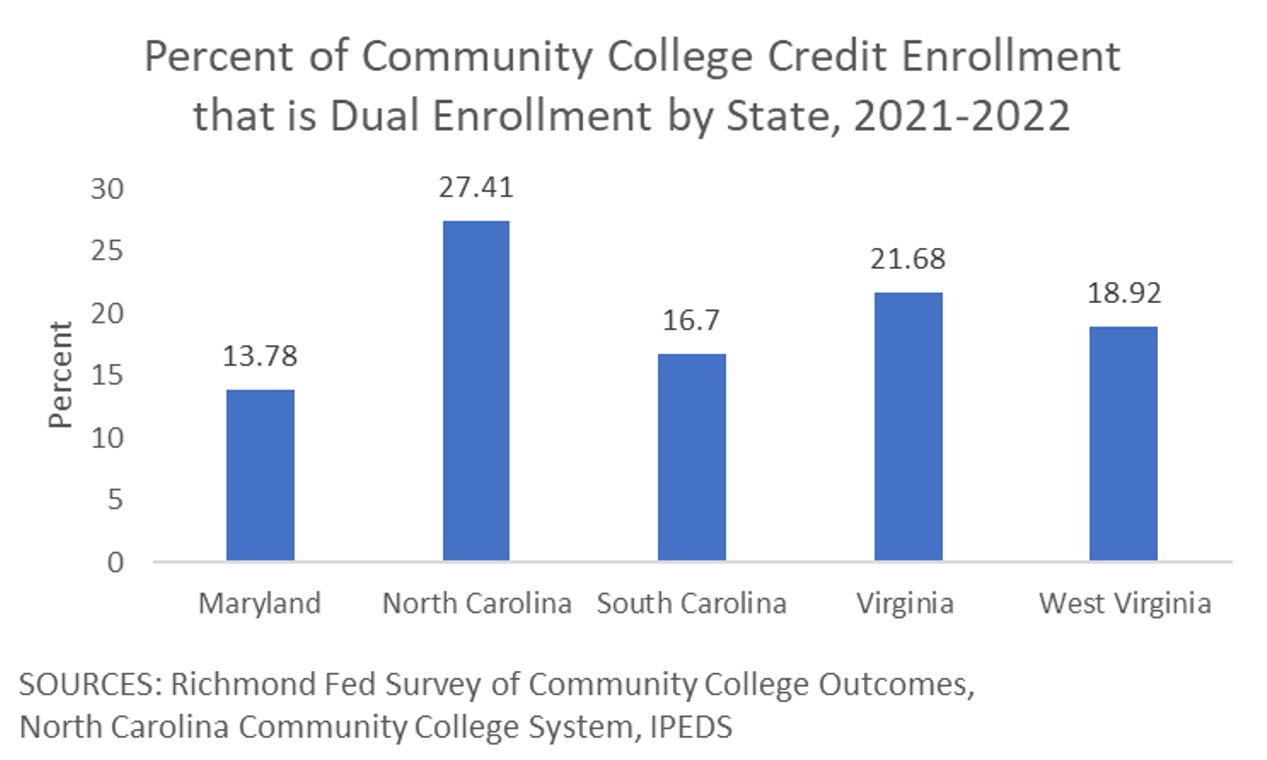Wraparound services like transportation assistance and child care foster student success. This post highlights how some community colleges are supporting student parents.
Funding Dual Enrollment Across the Fifth District
Attending college — to earn a degree or a technical certification — can be costly for many students and their families. Programs like dual enrollment, however, can take a lot of the sting out of paying for higher education by allowing students to take college-level coursework, and perhaps earn that degree or certification before even finishing high school. Local community colleges typically manage dual enrollment programs, where students' coursework may earn them both high school and college credit simultaneously.
While coursework through dual enrollment programs usually, but not always, ends up costing students less than if they took those classes after graduation as traditional college students, getting a clear picture of how the programs are funded can be difficult. There are four primary cost categories for dual enrollment programs: tuition, fees, books and supplies, and transportation. Funding to meet these costs generally comes from four sources: state appropriations, local school districts, community colleges, and students and their families. Oftentimes, however, more than one funding source will cover these costs even when there is an identified primary source.
Dual enrollment funding models vary widely within Fifth District states (Maryland, North Carolina, South Carolina, Virginia, and most of West Virginia), with some states paying for most costs through regular appropriations. Other states, however, have no state-level funding mechanism, and aside from high schools and community colleges that receive state funding for the number of fully enrolled students, who pays these costs varies from county to county and school district to school district. Understanding these variations in funding models is important, as they influence student participation patterns and eventual outcomes.
State Funding Models Across the Fifth District
Maryland
Until 2023, local school districts in Maryland were required to establish agreements with postsecondary schools to cover tuition and fees for eligible students enrolled in dual enrollment courses. Despite these arrangements, the school districts could still charge up to 90 percent of tuition back to the students, although students who were eligible for free or reduced meals had their tuition charges fully waived. Under a new model that became a law in 2023, the school district must pay 75 percent of dual enrollment tuition, and the community colleges may not charge tuition to any dually enrolled student. Further, according to Maryland law, both the school districts and community colleges must ensure that any tuition costs associated with dual enrollment are not passed on to students and their families. It's also worth noting that students enrolled in dual enrollment courses are counted as students at both their high school and at the community college, allowing both institutions to receive state funding for those students.
North Carolina
Since 2012, North Carolina's Career and College Promise (CCP) program has been funded through state-level appropriations. CCP fully covers tuition for dually enrolled high school students taking courses through three different pathways: students planning to continue their education at a community college or university, students seeking a certification or diploma in a technical field or career, and students enrolled in small public high schools located on the campuses of local community colleges who are working on both a high school diploma and an associate degree or other certification. Like Maryland's new system, North Carolina's dual enrollment students are considered students at both their high school and community college simultaneously, allowing both to get state funding for those students. The program does not cover transportation, books and supplies, or fees, although school districts and community colleges can contribute to the costs if funds are available.
South Carolina
South Carolina does not have a statewide funding system for the costs of dual enrollment, and some colleges charge tuition for those courses, while others do not. Students can also apply for scholarships such as the South Carolina Lottery Tuition Assistance program, which provides a partial tuition subsidy for students enrolled in at least six dual enrollment credit hours (usually two courses) in a semester. Students pursuing a professional certificate, industry-recognized credential, diploma, or degree in a program recognized as a critical workforce program by the State Board for Technical and Comprehensive Education from one of the state's technical colleges may also be able to obtain a SC-WINS scholarship. These scholarships — created to help address worker shortages throughout the state — cover any remaining tuition, fees, or other course-related expenses. While this allows some students pursuing technical credentials to have most of their costs met outside of transportation, other students may still have to pay many of the costs themselves, especially if their college does not fully cover the tuition.
Virginia
Virginia does not provide funding for dual enrollment at the state level, and there is no standard payment model, allowing the costs borne by the student to vary significantly. For instance, almost all community colleges charge tuition for dual enrollment, but each school district can make its own decision about whether and to what extent it will cover those costs: It can pay the community college the tuition, fund some portion of it, or pass the entire cost to the student. Further, the amount the community college charges can vary depending on the physical location of the course. In some parts of the state, if the course is taught in the high school or at a technical center, the amount the community college charges can be lower than if it was held on the college's campus, and in some cases, there may be no tuition charge at all.
West Virginia
West Virginia began a four-year pilot program in 2023 wherein high school students will no longer be responsible for tuition and fees related to their dual enrollment coursework. State appropriations will reimburse $75 per credit hour of the cost of dual enrollment courses to both community colleges and participating universities. The courses covered are linked to what the state sees as in-demand jobs: health care, information technology, engineering, STEM, education, advanced manufacturing, welding and fabrication, construction, and agriculture. Additional costs like books and supplies, as well as transportation, are left to the students or the school districts. Prior to the pilot, community colleges were limited to charging dual enrollment students $25 a credit hour with no appropriations offset from the state. The new funding in the pilot program is expected to significantly increase the number of dual enrollment students across the state.
Dual Enrollment Across Fifth District States
Dual enrollment accounts for an important, but varied, percentage of overall credit enrollment across the Fifth District. The figure above shows that between approximately 14 percent and 27 percent of the states' community college students taking for-credit classes were high school students during the 2021-2022 academic year. However, in Virginia, for example, where nearly 22 percent of students in traditional for-credit community college courses are also in high school, it may be that those colleges do not receive full funding for each of those students.
Pitfalls and Barriers
The Richmond Fed recently completed the extended pilot of the Survey of Community College Outcomes (SCCO) throughout the Fifth District, and the data from South Carolina's colleges indicate that the schools that pay students' dual enrollment tuition have higher shares of dual enrollment students than those that do not. Further, a 2018 study by the state of Maryland indicated dual enrollment students were disproportionately female, White, and come from more economically secure families. From the community colleges' perspectives, if they do not get funding from the state — or the school district — to cover tuition costs, they have no incentive to offer any meaningful dual enrollment programming, particularly if the students in the area have limited resources to pay the costs themselves.
Such gaps in access are problematic, especially when research has consistently shown that dual enrollment programs carry significant long-term benefits for those who use them. For example, the study in Maryland found that students who completed dual enrollment courses were more likely to enroll and persist in college and were 15 percentage points more likely to graduate from college within six years. Relatedly, dual enrollment participants earned $2,100 more six years after high school graduation than those students who did not participate. These effects were also more pronounced for minority and low-income students.
Conclusion
As Maryland and West Virginia shift to a funding model centered around state appropriations, researchers will want to monitor how those changes impact overall participation, as well as uptake among the students who can benefit most from increased access. States within the Fifth District, and across the country, want to create strong, educated workforces. Dual enrollment programs can play an important role in that effort, but they need to make sure the funding policies are available and effective.
Views expressed are those of the author(s) and do not necessarily reflect those of the Federal Reserve Bank of Richmond or the Federal Reserve System.
Receive an email notification when a new Community College Insights article posts:
Related Content
Community colleges can leverage a number of creative strategies and partnerships to provide long-term housing solutions for the unique student populations they serve.




